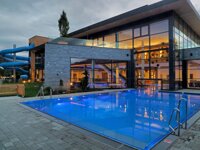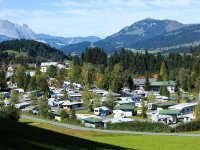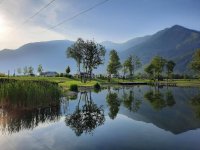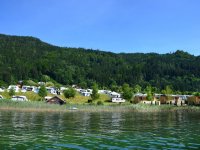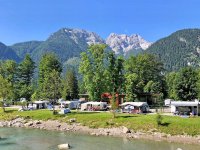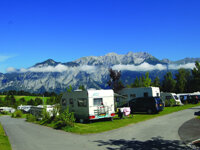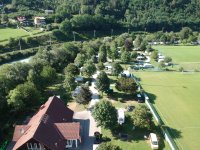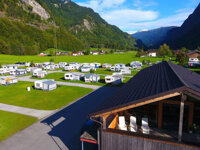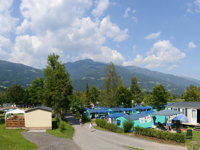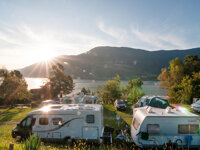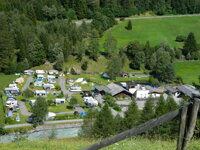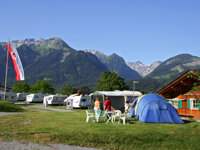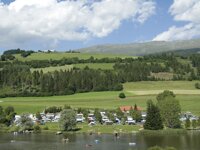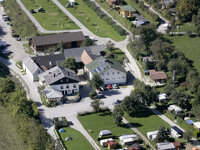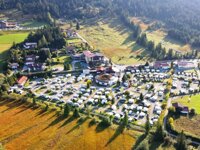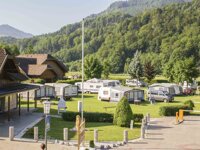Camping in Austria
91 campsites in Austria for Bicycle Hire
Campsite Listing Google Map
The following consent is required:
Tracking & performance, Targeting & advertising.
Austria
The land of postcard Alpine scenery, Swarovski Crystal and Mozart, Austria, has many charms to recommend it. The dramatic peaks of Tyrol are punctuated by lively cities such as Salzburg, Vienna and Graz, providing a contrasting and unique experience throughout the land.

The hustle and bustle of Salzburg, with its Baroque architecture, grand palaces and art museums, is tempered by the surrounding Salzkammergut, a region of peaceful Alpine scenery and glacial lakes. It’s the ideal place to engage in watersports and outdoor activities such as hiking, cycling and caving and to try culinary specialities such as Kaiserschmarrn, a sugared pancake dish with raisins and gingerbread. Hallstatt is a must-visit when you're camping in Austria, a picturesque town in Salzkammergut known for its salt production.
Austria has castles to rival Bavaria, one of the most impressive of which is Hohenwerfen Castle south of Salzberg. It's a popular tourist attraction with an extensive weapons collection and a falconry centre offering daily flight demonstrations and stunning views across the landscapes.
And what would a camping holiday in Austria be without a trip to its beautiful capital, Vienna?
This elegant city was home to several eminent composers for many years and now draws almost five million visitors every year. Main sights include the Schönbrunn Palace, which houses the world's oldest zoo, the Vienna State Opera and Beethoven's residences.
About Austria
Camping options in Austria

Austria is a beautiful country with stunning landscapes, making it a great destination for camping enthusiasts. Campsites in Austria are known for their excellent facilities, beautiful surroundings, and wide range of outdoor activities.
- Austrian Alps Camping: The Austrian Alps offer numerous mountain views and camping opportunities. Regions like Tyrol, Zillertal and Stubai are known for their alpine scenery, hiking trails, and skiing resorts.
- Austrian Lakeside Camping: Austria is home to numerous picturesque lakes, such as Lake Wolfgang (Wolfgangsee), Lake Neusiedl (Neusiedler See), and Lake Achen (Achensee). These lakeside camping sites provide swimming, boating, fishing, and relaxing opportunities by the water.
- Austrian National Parks: Austria boasts several national parks, including Hohe Tauern National Park, Gesäuse National Park, and Kalkalpen National Park. These protected areas offer camping options for nature lovers, with opportunities for hiking, wildlife spotting, and immersing yourself in unspoiled landscapes.
Basic information
Austria shares its borders with eight countries. Germany and the Czech Republic to the north, Hungary and Slovakia to the east, Slovenia and Italy to the south, with Switzerland and Liechtenstein to the west.
Austria is divided into nine provinces, also known as states or Bundesländer. These provinces are Burgenland, Carinthia, Lower Austria, Upper Austria, Salzburg, Styria, Tyrol, Vorarlberg, and Vienna. Each province has its distinct landscapes, cultural heritage, and attractions.
The country is known for its diverse topography. The Austrian Alps dominate the western and southern parts of the country, featuring majestic mountain ranges, including the Eastern Alps and the Central Alps. The highest peak in Austria is Grossglockner, standing at 3,798 meters (12,461 feet).

Capital Vienna
Currency Euro (EUR)
Language(s) German, Hungarian (Regional), Slovene (Regional) & Croatian (Regional)
Time Zones CET (GMT+01)
Summer (CEST) WEST (UTC+02)
Telephone Code +43
EU Member Yes
Schengen Area Yes
Tourism Websiteaustria.info
Shopping
Shopping in Austria can be a delightful experience, offering a blend of traditional markets, upscale boutiques, and modern shopping centres:
- Vienna: The main shopping street is Mariahilfer Strasse, which stretches over a mile and features a mix of department stores, international brands, and local shops. The Graben and Kärntner Strasse are popular shopping areas known for their luxury boutiques and high-end fashion stores. Naschmarkt is a famous open-air market offering fresh produce, spices, cheese, and international cuisine.
- Salzburg: The Getreidegasse, a historic street in the city centre, is lined with boutique shops, traditional Austrian crafts, and speciality stores. Take the chance to explore the traditional Christmas markets in Salzburg during the holiday season. Visit the Grünmarkt for local specialities and regional products.
- Graz: Herrengasse is the main shopping street, featuring fashion boutiques, trendy shops, and international brands. The Citypark Graz is a large shopping centre with various stores and dining options.

When in Austria, consider purchasing traditional handicrafts and souvenirs. Look for items such as Dirndl and Lederhosen (traditional clothing), Mozartkugeln (chocolate balls), Austrian wines, crystal glassware from brands like Swarovski, and wooden crafts like nutcrackers and figurines.
It's important to note that shopping hours in Austria typically follow regular business hours, with larger shops closing around 6:30 or 7:00 PM on weekdays and 5:00 PM on Saturdays. However, shopping centres and stores in tourist areas may have extended hours and be open on Sundays.
Remember to familiarize yourself with any tax refund policies for tourists, as you may be eligible for VAT (Value Added Tax) refunds on certain purchases made in Austria.
Money
Austria uses the Euro (€) as its official currency. Visitors to Austria will find that most places, including shops, restaurants, and hotels, accept credit and debit cards. However, carrying some cash is advisable, particularly when visiting smaller towns and villages where card acceptance may be limited. ATMs are widely available throughout the country, and many of them provide instructions in multiple languages.
Value Added Tax (VAT), known as "Umsatzsteuer" in German, is included in the prices of goods and services. The current standard VAT rate in Austria is 20%. However, Austria does offer tax-free shopping for non-EU residents. If you are eligible, you can claim a VAT refund for your purchases upon leaving the country. Just ask for a tax-free shopping form (usually available at participating stores) and follow the necessary procedures at the airport or border when departing Austria.
Public Holidays
Austria has several public holidays throughout the year:
- New Year's Day (Neujahrstag) - January 1st
- Epiphany (Heilige Drei Könige) - January 6th
- Saint Joseph's Day - March 19th (Carinthia, Styria, Tyrol & Vorarlberg only)
- Easter Monday (Ostermontag) - the day after Easter Sunday*
- Labor Day (Tag der Arbeit) - May 1st
- Saint Florian's Day - May 4th (Upper Austria only)
- Ascension Day (Christi Himmelfahrt) - 40 days after Easter*
- Whit Monday (Pfingstmontag) - the day after Pentecost Sunday*
- Corpus Christi (Fronleichnam) - 60 days after Easter*
- Assumption of Mary - August 15th
- Saint Rupert's Day - September 24th (Salzburg only)
- Plebiscite Day October 10th (Carinthia only)
- National Day (Nationalfeiertag) - October 26th
- All Saints' Day (Allerheiligen) - November 1st
- Saint Martin's Day - November 11th (Burgenland only)
- Saint Leopold's Day - November 15th (Lower Austria & Vienna only)
- Immaculate Conception (Mariä Empfängnis) - December 8th
- Christmas Day (Weihnachtstag) - December 25th
- St. Stephen's Day (Stephanitag) - December 26th
On these public holidays, banks, government offices, and many businesses, including shops and restaurants, may be closed or have limited opening hours. Public transport schedules may also be adjusted on these days.
* Some holidays, such as Easter Monday, Ascension Day, Whit Monday, and Corpus Christi, are movable feasts that depend on the date of Easter each year.
Driving in Austria
- Driving Side: Drive on the right-hand side of the road, overtake on the left, and give way to traffic on your right at intersections unless otherwise indicated. Rettungsgasse - Emergency lanes, where motorists move as far as possible, left or right in their respective lanes to create a route down the middle of traffic during congestion, are compulsory on motorways and dual carriageways.
- Driving License: Visitors must be 18 or older and hold a full valid driving licence to drive in Austria. Driving licences issued in EU and EEA countries are accepted.
- Speed Limits: Speed limits in Austria vary depending on the type of road and the vehicle you are driving. As a general guideline, the speed limits are:
-
- Urban areas: 50 km/h (31 mph)
- Open roads: 100 km/h (62 mph)
- Expressways (Schnellstraßen): 130 km/h (80 mph)
- Motorways (Autobahnen): 130 km/h (80 mph)
Speed limits can be lower in certain areas, such as construction zones or during adverse weather conditions. Always observe the posted speed limit signs.

- Seat belts: Wearing seat belts is mandatory for all passengers. Children under 14 must use appropriate child restraints.
- Mobile Phones: Using a handheld mobile phone while driving is illegal.
- Drink Driving: The legal blood alcohol content (BAC) limit for drivers in Austria is 0.05%. It is always recommended to avoid drinking and driving altogether.
- Winter Driving: If you plan to drive in Austria during winter, be prepared for winter driving conditions, especially in mountainous areas. Snow tires are mandatory during winter (from November 1st to April 15th), and it is recommended to have snow chains with you in case of heavy snowfall. Pay attention to weather forecasts, follow any instructions or restrictions in place, and drive cautiously on slippery or icy roads.
- Tolls: Austria has a toll system for its motorways (Autobahnen) and expressways (Schnellstraßen). You will need a valid toll sticker, known as a "Vignette," displayed on your vehicle's windshield. Vignettes can be purchased at filling stations, border crossings, post offices, and online. Different durations are available. Failure to display a valid vignette may result in fines.
- Compulsory Items: The following items are required when driving in Austria.
- Reflective jackets (which should be worn in case of breakdown outside built-up areas and on all major routes)
- Warning triangle (compulsory in every vehicle)
- First aid box (in a robust and dirt-proof box)
- Headlamp beam deflectors (depending on your car, you will either need deflector stickers or may have to adjust the beam manually)
Emergency Services
- Single European Emergency Number 112
- Fire service 122
- Police 133
- Mountain Rescue 140
- Medical Emergency Service 141
- Ambulance Service 144
Emergency numbers can be reached free of charge from any phone in Austria. The European 112 Emergency Number can be called from locked mobile phones without entering a PIN.
Climate
Austria has a temperate climate with four distinct seasons. The climate is influenced by the country's location in Central Europe and its varied topography, which includes alpine regions, lowlands, and plateaus.
- Spring (March to May): Spring in Austria is generally mild, with temperatures gradually rising. March can still be chilly, especially in higher elevations, while May brings warmer temperatures. Spring is a transitional season with occasional rainfall but also plenty of sunshine.
- Summer (June to August): Summers in Austria are pleasantly warm, particularly in the lowland areas. The average temperature can range from 20°C to 25°C (68°F to 77°F) but can occasionally reach higher values, especially during heatwaves. The alpine regions provide cooler temperatures, making them popular for escaping the summer heat. Rainfall is moderate, with occasional thunderstorms.
- Autumn (September to November): Autumn in Austria is characterized by mild and pleasant weather, particularly in September. The temperatures gradually cool, with October being cooler and November transitioning into winter. Rainfall increases during this season, but there are still many sunny days.
- Winter (December to February): Winters in Austria are cold, especially in the alpine regions, where snowfall is abundant. Temperatures can drop below freezing, with average daytime temperatures ranging from -1°C to 4°C (30°F to 39°F) in lowland areas. The alpine regions experience much colder temperatures. Winter is also the driest season, with some areas experiencing clear, sunny days.
It's important to note that Austria's climate can vary regionally due to its diverse topography. The alpine regions have cooler temperatures and more precipitation, while the eastern lowlands experience milder winters and hotter.
